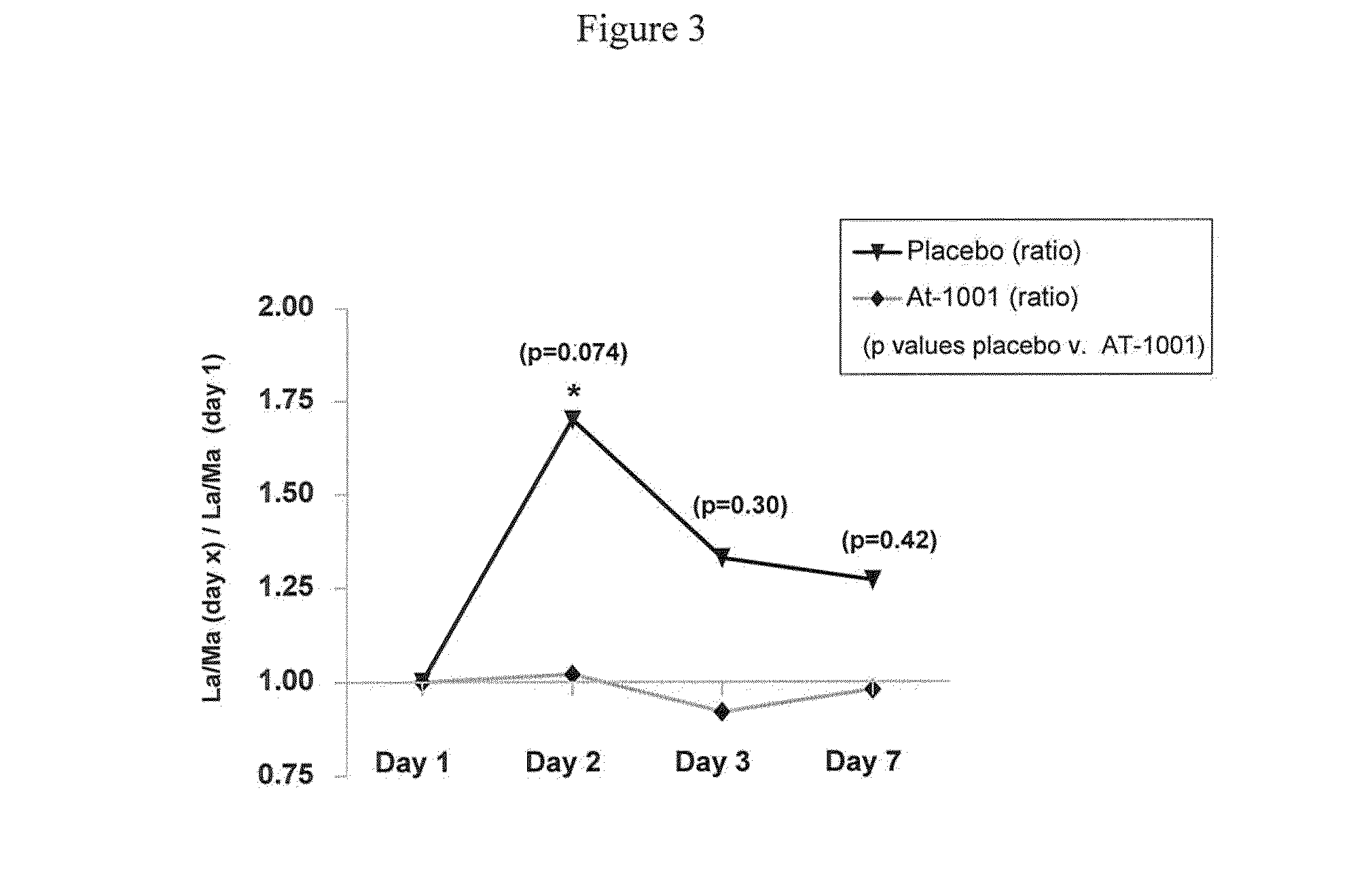Materials and methods for the treatment of celiac disease
a technology for celiac disease and materials, applied in the field of celiac disease materials and methods, can solve the problems of paracellular leakage (“leaky gut”) and the development of inappropriate immune responses to environmental antigens (i.e., gluten) and achieve the effects of preventing, treating and/or preventing celiac disease, preventing, enhancing and/or treating celiac diseas
- Summary
- Abstract
- Description
- Claims
- Application Information
AI Technical Summary
Benefits of technology
Problems solved by technology
Method used
Image
Examples
example 1
[0034]This was an inpatient, double-blind, randomized placebo controlled study to determine the safety, tolerability, pharmacokinetic and pharmacodynamic effects of 12 mg doses of AT-1001 in CD subjects. One cohort of 24 subjects was planned, with a 2:1 randomization (drug:placebo) for once daily dosing on Days 1, 2 and 3. On Day 2, all subjects would receive a 2.5 gram oral gluten challenge in single blind fashion.
[0035]Efficacy endpoints included changes in urinary lactulose-to-mannitol (L-to-M) ratios assessed on study days 1, 2, 3, and 7, self-reported measures of GI discomfort (visual analogue pain scale and three ordinal questions about bowel function), GI adverse events (AEs) an ordinal global outcomes assessment, urinary nitrites / nitrates and PBMC cell markers and cytokine levels.
[0036]Pharmacokinetic measures included serial plasma levels of AT-1001 collected at various times following administration of each treatment. Safety measures included monitoring of AEs, standard cl...
example 2
[0118]A Phase 2a, Randomized, Double-Blind, Placebo Controlled, Dose Ranging, Multicenter Study to Determine the Safety, Tolerance, and Efficacy of AT-1001 in Celiac Disease Subjects during Gluten Challenge.
[0119]The study was conducted at up to 12 sites in the United States, and was anticipated to run between September and December 2006.
[0120]Objectives:
[0121]To demonstrate the safety and tolerability of multiple, oral doses of AT-1001 in celiac disease subjects that maintain a gluten-free diet.
[0122]To demonstrate the safety and tolerability of multiple, oral doses of AT-1001 in celiac disease subjects “in remission” [anti-tTG (−)≦10 EU].
[0123]To evaluate the efficacy of multiple dose levels of AT-1001 in preventing intestinal permeability changes induced by gluten challenge.
[0124]Measure change in urinary lactulose-to-mannitol (La / Ma) ratio from Day 0 to Day 14; a measure of intestinal permeability in response to gluten exposure.
[0125]A sub-chronic measure of injury / unit area vs....
example 3
[0591]In Vivo Measurement of Intestinal Permeability
[0592]Selection of region specific probes allows for the determination of paracellular permeability in different segments (Arrieta et al. Gut. 55; pp 1512-1520 (2006)).
[0593]Lactulose:Mannitol (La / Ma) ratios provide information on the entire small bowel
[0594]LactuloseFE˜pore injury
[0595]MannitolFE˜absorptive surface area
[0596]La / Ma=injury / unit area
[0597]Subject Instructions for Intestinal Permeability Test
[0598]This is a safe, simple urine test designed to study changes in bowel permeability (leakiness), which may help us predict inflammation in the bowels.
[0599]Please follow the instructions carefully.
[0600]The test kit contains[0601]One bottle for urine collection[0602]One bottle of mannitol / lactulose syrup[0603]One collection “hat” to help you collect urine
[0604]Steps to follow:[0605]Do not drink alcohol for 2 days before performing the test.[0606]On the day before your scheduled study visit, take your study drug as directed and...
PUM
| Property | Measurement | Unit |
|---|---|---|
| concentrations | aaaaa | aaaaa |
| permeability | aaaaa | aaaaa |
| paracellular permeability | aaaaa | aaaaa |
Abstract
Description
Claims
Application Information
 Login to View More
Login to View More - R&D Engineer
- R&D Manager
- IP Professional
- Industry Leading Data Capabilities
- Powerful AI technology
- Patent DNA Extraction
Browse by: Latest US Patents, China's latest patents, Technical Efficacy Thesaurus, Application Domain, Technology Topic, Popular Technical Reports.
© 2024 PatSnap. All rights reserved.Legal|Privacy policy|Modern Slavery Act Transparency Statement|Sitemap|About US| Contact US: help@patsnap.com










